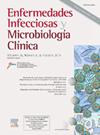Trends in point-prevalence surveys of healthcare-associated infections in acute care hospitals from the VINCat program in Catalonia, Spain (2008–2022)
IF 2.6
4区 医学
Q3 INFECTIOUS DISEASES
Enfermedades infecciosas y microbiologia clinica
Pub Date : 2025-01-16
DOI:10.1016/j.eimc.2024.12.002
引用次数: 0
Abstract
Introduction
Point prevalence surveys (PPS) offer valuable insights into the burden of healthcare-associated infections (HAIs) and antibiotic utilization. Our objective was to analyze trends of HAIs, medical device use, and antibiotic administration among hospitalized adult patients from 2008 to 2022, drawing on data from the VINCat Program in Catalonia, Spain.
Methods
The study compares aggregated data from PPS carried out over three 5-year periods (2008–2012, 2013–2017, and 2018–2022) gathered in a one-day survey carried out in May of each calendar year. Trained infection control personnel collected demographic and clinical data and information on device use and antibiotic administration. Criteria from the ECDC were used to define active HAI.
Results
Surveys were conducted at 56 acute care hospitals and included 59,454 patients: 14,914 (period 1), 19,916 (period 2) and 24,624 (period 3). Overall, 3986 patients (6.7%, 95% confidence interval: 6.5–6.9) had one or more HAIs. The trend of HAIs showed a U-shape, falling overall since 2008 but rising during the COVID-19 pandemic. Although there was a significant increase in the use of invasive devices, surgical site infections (SSI) were the most frequently reported HAIs across the three periods. The prevalence of antimicrobial therapy exhibited a significant rise from 33.3% of patients during period 1 to 39.2% in period 3.
Conclusion
Although there was an overall downward trend in HAIs during the study period, there was also a significant increase in antibiotic consumption. The data showed that SSI was the most prevalent HAI. This information was used to reinforce prevention activities.
西班牙加泰罗尼亚VINCat项目急诊医院医疗保健相关感染点流行调查趋势(2008-2022年)
流行病学调查(PPS)为卫生保健相关感染(HAIs)和抗生素使用的负担提供了有价值的见解。我们的目的是分析2008年至2022年住院成人患者HAIs、医疗器械使用和抗生素给药的趋势,数据来自西班牙加泰罗尼亚的VINCat项目。方法本研究比较了PPS在每个日历年5月进行的为期一天的调查中收集的三个五年期(2008-2012年、2013-2017年和2018-2022年)的汇总数据。训练有素的感染控制人员收集了有关器械使用和抗生素使用的人口统计和临床数据和信息。使用ECDC的标准来定义活动HAI。结果在56家急症医院进行了调查,共纳入59,454例患者:14,914例(一期),19,916例(二期)和24,624例(三期)。总体而言,3986例(6.7%,95%置信区间:6.5-6.9)患者存在一个或多个hai。自2008年以来,HAIs总体呈下降趋势,但在新冠肺炎大流行期间呈上升趋势。虽然侵入性器械的使用显著增加,但手术部位感染(SSI)是三个时期报告的最常见的HAIs。抗菌药物治疗的流行率从第1期的33.3%上升到第3期的39.2%。结论研究期间,虽然HAIs总体呈下降趋势,但抗生素消费量也有明显增加。数据显示SSI是最常见的HAI。这些信息被用来加强预防活动。
本文章由计算机程序翻译,如有差异,请以英文原文为准。
求助全文
约1分钟内获得全文
求助全文
来源期刊
CiteScore
2.10
自引率
8.00%
发文量
194
审稿时长
29 days
期刊介绍:
Hoy está universalmente reconocida la renovada y creciente importancia de la patología infecciosa: aparición de nuevos agentes patógenos, de cepas resistentes, de procesos con expresión clínica hasta ahora desconocida, de cuadros de una gran complejidad. Paralelamente, la Microbiología y la Infectología Clínicas han experimentado un gran desarrollo como respuesta al reto planteado por la actual patología infecciosa. Enfermedades Infecciosas y Microbiología Clínica es la Publicación Oficial de la Sociedad Española SEIMC. Cumple con la garantía científica de esta Sociedad, la doble función de difundir trabajos de investigación, tanto clínicos como microbiológicos, referidos a la patología infecciosa, y contribuye a la formación continuada de los interesados en aquella patología mediante artículos orientados a ese fin y elaborados por autores de la mayor calificación invitados por la revista.

 求助内容:
求助内容: 应助结果提醒方式:
应助结果提醒方式:


